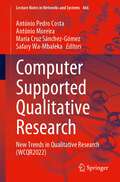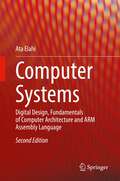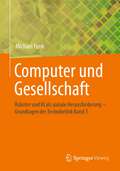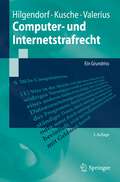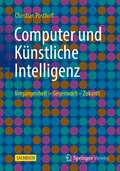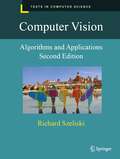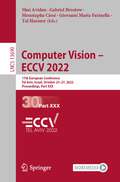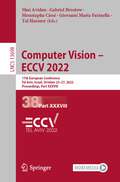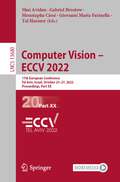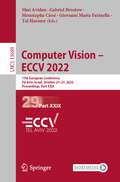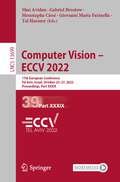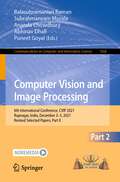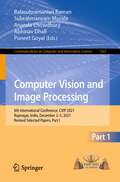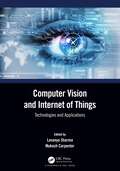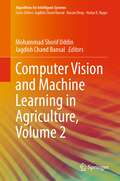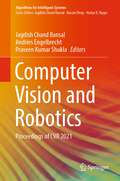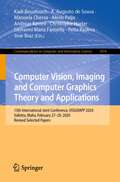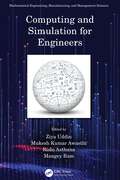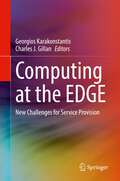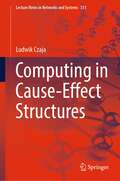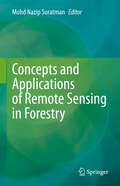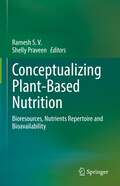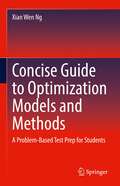- Table View
- List View
Computer Supported Qualitative Research: New Trends in Qualitative Research (WCQR2022) (Lecture Notes in Networks and Systems #466)
by António Pedro Costa António Moreira Maria Cruz Sánchez‑Gómez Safary Wa-MbalekaThis book includes selecting the articles accepted for presentation and discussion at WCQR2022, held on January 26 to 28, 2022 (Virtual Conference). The World Conference on Qualitative Research (WCQR) is an annual event that aims to bring together researchers, academics and professionals, promoting the sharing and discussion of knowledge, new perspectives, experiences and innovations on qualitative research. WCQR2022 featured four main application fields (education, health, social sciences, and engineering/technology) and seven main subjects: Rationale and paradigms of qualitative research; systematization of approaches with qualitative studies; qualitative and mixed methods research; data analysis types; innovative processes of qualitative data analysis; qualitative research in Web context; and qualitative analysis with software support. The book is a valuable resource for everyone interested in qualitative research, emphasizing computer-assisted qualitative data analysis software (CAQDAS).
Computer Systems: Digital Design, Fundamentals of Computer Architecture and ARM Assembly Language
by Ata ElahiThis updated textbook covers digital design, fundamentals of computer architecture, and ARM assembly language. The book starts by introducing computer abstraction, basic number systems, character coding, basic knowledge in digital design, and components of a computer. The book goes on to discuss information representation in computing, Boolean algebra and logic gates, and sequential logic. The book also presents introduction to computer architecture, Cache mapping methods, and virtual memory. The author also covers ARM architecture, ARM instructions, ARM assembly language using Keil development tools, and bitwise control structure using C and ARM assembly language. The book includes a set of laboratory experiments related to digital design using Logisim software and ARM assembly language programming using Keil development tools. In addition, each chapter features objectives, summaries, key terms, review questions, and problems.
Computer und Gesellschaft: Roboter und KI als soziale Herausforderung – Grundlagen der Technikethik Band 3
by Michael FunkWelche Wirkungen haben Robotik und Künstliche Intelligenz (KI) auf die Gesellschaft? Wie verändern Algorithmen und Machine Learning unser soziales Umfeld? Vor welchen ethischen Herausforderungen stehen wir? Vorliegendes Buch bietet zu diesen und weiteren Fragen systematische Analysen. Allgemeine und spezielle Roboterkonzepte von Androiden über Social Robots bis hin zu kollaborativen Industrierobotern werden vorgestellt. Hinzu treten Drohnen im militärischen und zivilen Einsatz sowie diverse Formen der Mensch-Maschine-, Tier-Maschine- und Pflanze-Maschine-Interaktion. Verschiedene Begriffe und Paradigmen der KI werden auch abseits der Informatik herausgearbeitet, reale und spekulative Entwicklungen eingeordnet. Vor diesem Hintergrund geraten ethisch-gesellschaftliche Brennpunkte in den Blick. Beispiele, Aufgaben, vertiefende Infos zu Hintergründen und Übersichten laden zum kritischen Weiterdenken ein. Es bildet den dritten, in sich abgerundeten Teil der Buchreihe Grundlagen der Technikethik.Haben wir die Zukunft, die wir brauchen, und brauchen wir die Zukunft, die wir haben?
Computer- und Internetstrafrecht: Ein Grundriss (Springer-Lehrbuch)
by Eric Hilgendorf Carsten Kusche Brian ValeriusDie Informations- und Kommunikationstechnologie stellt das Strafrecht vor die Aufgabe, sowohl klassische Delikte in ihrem neuen technisierten Gewand zu erfassen als auch ganz neuen Kriminalitätsformen zu begegnen. Das Lehrbuch vermittelt einen umfassenden Überblick über das Rechtsgebiet und zeigt die aktuellen Probleme auf. Die 2. Auflage berücksichtigt Entwicklungen in Gesetzgebung und Rechtsprechung und enthält ein neues Kapitel zu strafverfahrensrechtlichen Fragen im Zusammenhang mit Computern und Computernetzwerken.
Computer und Künstliche Intelligenz: Vergangenheit - Gegenwart - Zukunft
by Christian PosthoffDas Buch beginnt mit einer Erklärung der menschlichen Intelligenz und der Beschreibung von Intelligenztests. Die Künstliche Intelligenz, die auf Computerprogrammen beruht, beginnt mit der Dartmouth – Konferenz 1956, an der sich berühmte Informatiker dieser Zeit beteiligten. Diese damit eingeleitete Entwicklung wurde von großen Fortschritten der Kybernetik und der Spieltheorie begleitet.Es folgen Beschreibungen wichtiger Methoden und Anwendungen:Maschinelles Lernen und Neuronale Netze Sehr publikumswirksam waren die Entwicklungen von Programmen für strategische Spiele, die nach einem kurzen Training die jeweiligen Weltmeister besiegen konnten. Die Sprachübersetzer von Google und DeepL sind mittlerweile vielen bekannt. Es wird erklärt, wie intelligente Systeme mit Datenbanken zusammenarbeiten, wie beliebige Daten digitalisiert werden können. Große Mengen an Daten werden unter dem Stichwort „Big Data“ behandelt. Ausführlich beschrieben werden die Bildverarbeitung, die Erkennung von Tumoren und Viren. Robotik ist ein weiterer Punkt, der ausführlich dargestellt wird. Roboter in der Chirurgie und in der Pflege sind ebenfalls sehr bedeutsam. „Exotische Ausreißer“ sind die Anwendungen in der Kunst. Sehr bedeutsam für die zukünftige Entwicklung sind Anwendungen in der Rechtssprechung.
Computer Vision: Algorithms and Applications (Texts in Computer Science)
by Richard SzeliskiComputer Vision: Algorithms and Applications explores the variety of techniques used to analyze and interpret images. It also describes challenging real-world applications where vision is being successfully used, both in specialized applications such as image search and autonomous navigation, as well as for fun, consumer-level tasks that students can apply to their own personal photos and videos.More than just a source of “recipes,” this exceptionally authoritative and comprehensive textbook/reference takes a scientific approach to the formulation of computer vision problems. These problems are then analyzed using the latest classical and deep learning models and solved using rigorous engineering principles.Topics and features:Structured to support active curricula and project-oriented courses, with tips in the Introduction for using the book in a variety of customized coursesIncorporates totally new material on deep learning and applications such as mobile computational photography, autonomous navigation, and augmented realityPresents exercises at the end of each chapter with a heavy emphasis on testing algorithms and containing numerous suggestions for small mid-term projectsIncludes 1,500 new citations and 200 new figures that cover the tremendous developments from the last decadeProvides additional material and more detailed mathematical topics in the Appendices, which cover linear algebra, numerical techniques, estimation theory, datasets, and softwareSuitable for an upper-level undergraduate or graduate-level course in computer science or engineering, this textbook focuses on basic techniques that work under real-world conditions and encourages students to push their creative boundaries. Its design and exposition also make it eminently suitable as a unique reference to the fundamental techniques and current research literature in computer vision.
Computer Vision – ECCV 2022: 17th European Conference, Tel Aviv, Israel, October 23–27, 2022, Proceedings, Part XXX (Lecture Notes in Computer Science #13690)
by Shai Avidan Gabriel Brostow Moustapha Cissé Giovanni Maria Farinella Tal HassnerThe 39-volume set, comprising the LNCS books 13661 until 13699, constitutes the refereed proceedings of the 17th European Conference on Computer Vision, ECCV 2022, held in Tel Aviv, Israel, during October 23–27, 2022. The 1645 papers presented in these proceedings were carefully reviewed and selected from a total of 5804 submissions. The papers deal with topics such as computer vision; machine learning; deep neural networks; reinforcement learning; object recognition; image classification; image processing; object detection; semantic segmentation; human pose estimation; 3d reconstruction; stereo vision; computational photography; neural networks; image coding; image reconstruction; object recognition; motion estimation.
Computer Vision – ECCV 2022: 17th European Conference, Tel Aviv, Israel, October 23–27, 2022, Proceedings, Part XXXVIII (Lecture Notes in Computer Science #13698)
by Shai Avidan Gabriel Brostow Moustapha Cissé Giovanni Maria Farinella Tal HassnerThe 39-volume set, comprising the LNCS books 13661 until 13699, constitutes the refereed proceedings of the 17th European Conference on Computer Vision, ECCV 2022, held in Tel Aviv, Israel, during October 23–27, 2022. The 1645 papers presented in these proceedings were carefully reviewed and selected from a total of 5804 submissions. The papers deal with topics such as computer vision; machine learning; deep neural networks; reinforcement learning; object recognition; image classification; image processing; object detection; semantic segmentation; human pose estimation; 3d reconstruction; stereo vision; computational photography; neural networks; image coding; image reconstruction; object recognition; motion estimation.
Computer Vision – ECCV 2022: 17th European Conference, Tel Aviv, Israel, October 23–27, 2022, Proceedings, Part XX (Lecture Notes in Computer Science #13680)
by Shai Avidan Gabriel Brostow Moustapha Cissé Giovanni Maria Farinella Tal HassnerThe 39-volume set, comprising the LNCS books 13661 until 13699, constitutes the refereed proceedings of the 17th European Conference on Computer Vision, ECCV 2022, held in Tel Aviv, Israel, during October 23–27, 2022. The 1645 papers presented in these proceedings were carefully reviewed and selected from a total of 5804 submissions. The papers deal with topics such as computer vision; machine learning; deep neural networks; reinforcement learning; object recognition; image classification; image processing; object detection; semantic segmentation; human pose estimation; 3d reconstruction; stereo vision; computational photography; neural networks; image coding; image reconstruction; object recognition; motion estimation.
Computer Vision – ECCV 2022: 17th European Conference, Tel Aviv, Israel, October 23–27, 2022, Proceedings, Part XXIX (Lecture Notes in Computer Science #13689)
by Shai Avidan Gabriel Brostow Moustapha Cissé Giovanni Maria Farinella Tal HassnerThe 39-volume set, comprising the LNCS books 13661 until 13699, constitutes the refereed proceedings of the 17th European Conference on Computer Vision, ECCV 2022, held in Tel Aviv, Israel, during October 23–27, 2022. The 1645 papers presented in these proceedings were carefully reviewed and selected from a total of 5804 submissions. The papers deal with topics such as computer vision; machine learning; deep neural networks; reinforcement learning; object recognition; image classification; image processing; object detection; semantic segmentation; human pose estimation; 3d reconstruction; stereo vision; computational photography; neural networks; image coding; image reconstruction; object recognition; motion estimation.
Computer Vision – ECCV 2022: 17th European Conference, Tel Aviv, Israel, October 23–27, 2022, Proceedings, Part XXXIX (Lecture Notes in Computer Science #13699)
by Shai Avidan Gabriel Brostow Moustapha Cissé Giovanni Maria Farinella Tal HassnerThe 39-volume set, comprising the LNCS books 13661 until 13699, constitutes the refereed proceedings of the 17th European Conference on Computer Vision, ECCV 2022, held in Tel Aviv, Israel, during October 23–27, 2022. The 1645 papers presented in these proceedings were carefully reviewed and selected from a total of 5804 submissions. The papers deal with topics such as computer vision; machine learning; deep neural networks; reinforcement learning; object recognition; image classification; image processing; object detection; semantic segmentation; human pose estimation; 3d reconstruction; stereo vision; computational photography; neural networks; image coding; image reconstruction; object recognition; motion estimation.
Computer Vision and Image Processing: 6th International Conference, CVIP 2021, Rupnagar, India, December 3–5, 2021, Revised Selected Papers, Part II (Communications in Computer and Information Science #1568)
by Balasubramanian Raman Subrahmanyam Murala Ananda Chowdhury Abhinav Dhall Puneet GoyalThis two-volume set (CCIS 1567-1568) constitutes the refereed proceedings of the 6h International Conference on Computer Vision and Image Processing, CVIP 2021, held in Rupnagar, India, in December 2021. The 70 full papers and 20 short papers were carefully reviewed and selected from the 260 submissions. The papers present recent research on such topics as biometrics, forensics, content protection, image enhancement/super-resolution/restoration, motion and tracking, image or video retrieval, image, image/video processing for autonomous vehicles, video scene understanding, human-computer interaction, document image analysis, face, iris, emotion, sign language and gesture recognition, 3D image/video processing, action and event detection/recognition, medical image and video analysis, vision-based human GAIT analysis, remote sensing, and more.
Computer Vision and Image Processing: 6th International Conference, CVIP 2021, Rupnagar, India, December 3–5, 2021, Revised Selected Papers, Part I (Communications in Computer and Information Science #1567)
by Balasubramanian Raman Subrahmanyam Murala Ananda Chowdhury Abhinav Dhall Puneet GoyalThis two-volume set (CCIS 1567-1568) constitutes the refereed proceedings of the 6h International Conference on Computer Vision and Image Processing, CVIP 2021, held in Rupnagar, India, in December 2021. The 70 full papers and 20 short papers were carefully reviewed and selected from the 260 submissions. The papers present recent research on such topics as biometrics, forensics, content protection, image enhancement/super-resolution/restoration, motion and tracking, image or video retrieval, image, image/video processing for autonomous vehicles, video scene understanding, human-computer interaction, document image analysis, face, iris, emotion, sign language and gesture recognition, 3D image/video processing, action and event detection/recognition, medical image and video analysis, vision-based human GAIT analysis, remote sensing, and more.
Computer Vision and Internet of Things: Technologies and Applications
by Lavanya Sharma Mukesh CarpenterComputer Vision and Internet of Things: Technologies and Applications explores the utilization of Internet of Things (IoT) with computer vision and its underlying technologies in different applications areas. Using a series of present and future applications – including business insights, indoor-outdoor securities, smart grids, human detection and tracking, intelligent traffic monitoring, e-health departments, and medical imaging – this book focuses on providing a detailed description of the utilization of IoT with computer vision and its underlying technologies in critical application areas, such as smart grids, emergency departments, intelligent traffic cams, insurance, and the automotive industry. Key Features • Covers the challenging issues related to sensors, detection, and tracking of moving objects with solutions to handle relevant challenges • Describes the latest technological advances in IoT and computer vision with their implementations • Combines image processing and analysis into a unified framework to understand both IOT and computer vision applications • Explores mining and tracking of motion-based object data, such as trajectory prediction and prediction of a particular location of object data, and their critical applications • Provides novel solutions for medical imaging (skin lesion detection, cancer detection, enhancement techniques for MRI images, and automated disease prediction) This book is primarily aimed at graduates and researchers working in the areas of IoT, computer vision, big data, cloud computing, and remote sensing. It is also an ideal resource for IT professionals and technology developers.
Computer Vision and Internet of Things: Technologies and Applications
by Lavanya SharmaComputer Vision and Internet of Things: Technologies and Applications explores the utilization of Internet of Things (IoT) with computer vision and its underlying technologies in different applications areas. Using a series of present and future applications – including business insights, indoor-outdoor securities, smart grids, human detection and tracking, intelligent traffic monitoring, e-health departments, and medical imaging – this book focuses on providing a detailed description of the utilization of IoT with computer vision and its underlying technologies in critical application areas, such as smart grids, emergency departments, intelligent traffic cams, insurance, and the automotive industry. Key Features • Covers the challenging issues related to sensors, detection, and tracking of moving objects with solutions to handle relevant challenges • Describes the latest technological advances in IoT and computer vision with their implementations • Combines image processing and analysis into a unified framework to understand both IOT and computer vision applications • Explores mining and tracking of motion-based object data, such as trajectory prediction and prediction of a particular location of object data, and their critical applications • Provides novel solutions for medical imaging (skin lesion detection, cancer detection, enhancement techniques for MRI images, and automated disease prediction) This book is primarily aimed at graduates and researchers working in the areas of IoT, computer vision, big data, cloud computing, and remote sensing. It is also an ideal resource for IT professionals and technology developers.
Computer Vision and Machine Learning in Agriculture, Volume 2 (Algorithms for Intelligent Systems)
by Mohammad Shorif Uddin Jagdish Chand BansalThis book is as an extension of previous book “Computer Vision and Machine Learning in Agriculture” for academicians, researchers, and professionals interested in solving the problems of agricultural plants and products for boosting production by rendering the advanced machine learning including deep learning tools and techniques to computer vision algorithms. The book contains 15 chapters. The first three chapters are devoted to crops harvesting, weed, and multi-class crops detection with the help of robots and UAVs through machine learning and deep learning algorithms for smart agriculture. Next, two chapters describe agricultural data retrievals and data collections. Chapters 6, 7, 8 and 9 focuses on yield estimation, crop maturity detection, agri-food product quality assessment, and medicinal plant recognition, respectively. The remaining six chapters concentrates on optimized disease recognition through computer vision-based machine and deep learning strategies.
Computer Vision and Robotics: Proceedings of CVR 2021 (Algorithms for Intelligent Systems)
by Jagdish Chand Bansal Andries Engelbrecht Praveen Kumar ShuklaThis book consists of a collection of the high-quality research articles in the field of computer vision and robotics which are presented in the International Conference on Computer Vision and Robotics (CVR 2021), organized by BBD University Lucknow, India, during 7–8 August 2021. The book discusses applications of computer vision and robotics in the fields like medical science, defence, and smart city planning. The book presents recent works from researchers, academicians, industry, and policy makers.
Computer Vision, Imaging and Computer Graphics Theory and Applications: 15th International Joint Conference, VISIGRAPP 2020 Valletta, Malta, February 27–29, 2020, Revised Selected Papers (Communications in Computer and Information Science #1474)
by Petia Radeva Giovanni Maria Farinella Andreas Kerren Christophe Hurter Manuela Chessa Kadi Bouatouch Alexis Paljic A. Augusto de Sousa Jose BrazThis book constitutes thoroughly revised and selected papers from the 15th International Joint Conference on Computer Vision, Imaging and Computer Graphics Theory and Applications, VISIGRAPP 2020, held in Valletta, Malta, in February 2020.The 25 thoroughly revised and extended papers presented in this volume were carefully reviewed and selected from 455 submissions. The papers contribute to the understanding of relevant trends of current research on computer graphics; human computer interaction; information visualization; computer vision.
Computing and Simulation for Engineers (ISSN)
by Ziya Uddin Mukesh Kumar Awasthi Rishi Asthana Mangey RamThis book presents the reader with comprehensive insight into various kinds of mathematical modeling and numerical computation for problems arising in several branches of engineering, such as mechanical engineering, computer science engineering, electrical engineering, electronics and communication engineering, and civil engineering.The book: • Discusses topics related to clean and green energy production and storage • Bridges the gap between core theory and costly industrial experiments • Covers advanced biomechanics and nanodrug delivery topics • Explores diversified applications of mathematical techniques to solve practical engineering problems The text in this book emphasizes mathematical treatment of soft computing, image and signal processing, fluid flows in various geometries, biomechanics, biological modeling, a mathematical description of the solar cell, analytical and numerical treatment of problems in fracture mechanics, and antenna design modeling. It also discusses the numerical computations of biomechanics problems and problems arising in cryptography. The text further covers optimization techniques that are useful for real-world problems. This material is primarily written for graduate students and academic researchers in a number of engineering fields, including electrical, electronics and communication, industrial, manufacturing, mechanical, computer science, and mathematics.
Computing and Simulation for Engineers (ISSN)
by Ziya UddinThis book presents the reader with comprehensive insight into various kinds of mathematical modeling and numerical computation for problems arising in several branches of engineering, such as mechanical engineering, computer science engineering, electrical engineering, electronics and communication engineering, and civil engineering.The book: • Discusses topics related to clean and green energy production and storage • Bridges the gap between core theory and costly industrial experiments • Covers advanced biomechanics and nanodrug delivery topics • Explores diversified applications of mathematical techniques to solve practical engineering problems The text in this book emphasizes mathematical treatment of soft computing, image and signal processing, fluid flows in various geometries, biomechanics, biological modeling, a mathematical description of the solar cell, analytical and numerical treatment of problems in fracture mechanics, and antenna design modeling. It also discusses the numerical computations of biomechanics problems and problems arising in cryptography. The text further covers optimization techniques that are useful for real-world problems. This material is primarily written for graduate students and academic researchers in a number of engineering fields, including electrical, electronics and communication, industrial, manufacturing, mechanical, computer science, and mathematics.
Computing at the EDGE: New Challenges for Service Provision
by Georgios Karakonstantis Charles J. GillanThis book describes solutions to the problems of energy efficiency, resiliency and cyber security in the domain of Edge Computing and reports on early deployments of the technology in commercial settings. This book takes a business focused view, relating the technological outcomes to new business opportunities made possible by the edge paradigm. Drawing on the experience of end user deploying prototype edge technology, the authors discuss applications in financial management, wireless management, and social networks. Coverage includes a chapter on the analysis of total cost of ownership, thereby enabling readers to calculate the efficiency gain for use of the technology in their business.Provides a single-source reference to the state-of-the art of edge computing;Describes how researchers across the world are addressing challenges relating to power efficiency, ease of programming and emerging cyber security threats in this domain;Discusses total cost of ownership for applications in financial management and social networks;Discusses security challenges in wireless management.
Computing in Cause-Effect Structures (Lecture Notes in Networks and Systems #331)
by Ludwik CzajaThis book focuses on numerous examples of tasks represented by c-e structure. Cause–effect (c-e) structures are dynamic objects devised for algebraic and graphic description of realistic tasks. They constitute a formal system providing means to specify or implement (depending on degree of description generality) the tasks. They can be transformed, thus come under simplification, in accordance with rules-axioms of their algebra. Also, their properties can be inferred from the axioms. One objective of this book is presentation, by many realistic examples, of computing capability of c-e structures, without entering into mathematical details of their algebra. In particular, how computing with natural numbers and in propositional calculus can be performed by c-e structures and how to specify behavior of data structures. But also demonstration of many other tasks taken from the area of parallel processing, specified as c-e structures. Another objective is modelling or simulation by means of c-e structures, of other descriptive systems, devised for tasks from various fields. Also without formalizing by usage of functions between the systems. This concerns formalisms such as reaction systems, rough sets, Petri nets and CSP-like languages. Also on such, where temporal interdependence between actions matters. The presentation of examples is prevalently graphic, in the form of peculiar nets, but accompanied by their algebraic and set-theoretic expressions. A fairly complete exposition of concepts and properties of the algebra of cause-effect structures is in the previous book appeared in the Lecture Notes in Networks and Systems series. But basic notions of c-e structures are here provided for understanding the examples.
Concepts and Applications of Remote Sensing in Forestry
by Mohd Nazip SuratmanThis edited book is a collection of information on recent advancements in remote sensing for forestry application. The main focus of this book is to address the novel applications in remote sensing in terms of recent techniques, sensors, methods and data collection. Remote sensing has been used for many decades. Today, remote sensing is heavily utilized in forest management, which is acquired from airborne and space-borne platforms using satellite data. In recent years, there have been rapid advances in the new types of sensors. The new generations of satellite sensors are introduced not only to provide important information on forest ecosystems, but also to improve the techniques and accuracies obtained by the traditional approaches. Researchers have become increasingly aware of the potential of remote sensing to address important forestry issues and challenges. The number of forestry publications using remote sensing has grown very rapidly, and this is noticeable with many recent technologies and applications. This book provides valuable source of reference to foresters, researchers, ecologists, climate change scientists and scholars who use remote sensing in their work. Furthermore, it serves as an academic book for undergraduate and graduate students of forestry, agriculture, natural resources and environmental sciences. The book demonstrates and engages the students how the new advancements in remote sensing technology and theory relate to the many real-world forestry applications. It gives readers deeper understanding on how remote sensing has come a long way and evolved into a mature science in the past five decades.
Conceptualizing Plant-Based Nutrition: Bioresources, Nutrients Repertoire and Bioavailability
by Ramesh S. V. Shelly PraveenThis book deliberates on the various aspects of plant-based nutrition. Plant-based nutrition has numerous potential health benefits as it is low on calories nevertheless high on nutrient density and satiety, and also nutrient supplementation makes them wholesome diets.Starting with the importance of biodiversity contributing to the nutrition, the book discusses the development or utilization of nutrient-dense crops/foods with their bioavailability properties and health effects. Further, it deals with the enrichment of micronutrients through bio-fortification, fortification, the role of food matrix, and nutrient bioavailability, including the role of plant-based milk alternatives. The linkage between food and health is also being discussed in the context of anti-nutritional factors, metabolic fate of the food, and genomics. Finally, the implications of next-gen biotech crops and food safety issues imperative to define the concept of safe nutrition are discussed.With contributions from plant nutrition experts, this book serves as a one-stop reference for plant scientists, food technologists, and nutritionists looking to understand the concept of plant-based nutrition and its linkage with human health.
Concise Guide to Optimization Models and Methods: A Problem-Based Test Prep for Students
by Xian Wen NgThis concise text contains the most commonly-encountered examination problems in the topic of Optimization Models and Methods, an important module in engineering and other disciplines where there exists an increasing need to operate optimally and sustainably under constraints, such as tighter resource availability, environmental consideration, and cost pressures. This book is comprehensive in coverage as it includes a diverse spectrum of problems from numerical open-ended questions that probe creative thinking to the relation of concepts to realistic settings. The book adopts many examples of design scenarios as context for curating sample problems. This will help students relate desktop problem-solving to tackling real-world problems. Succinct yet rigorous, with over a 100 pages of problems and corresponding worked solutions presented in detail, the book is ideal for students of engineering, applied science, and market analysis.
